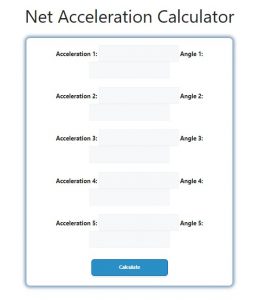About Net Acceleration Calculator (Formula)
The Net Acceleration Calculator is a valuable tool for physicists, engineers, and students who need to determine the resultant acceleration of an object based on multiple vectors. In many real-world applications, objects experience different accelerations acting at various angles. This calculator helps simplify the process of combining these accelerations into a single net acceleration vector, making it easier to analyze motion in two dimensions.
Formula
To calculate the net acceleration, you will use the following formulas:
For the x-component:
Ax = A1 * cos(a1) + A2 * cos(a2) + …
For the y-component:
Ay = A1 * sin(a1) + A2 * sin(a2) + …
To find the magnitude of the net acceleration:
Amag = SQRT(Vx^2 + Vy^2)
How to Use
Using the Net Acceleration Calculator is straightforward. Follow these steps:
- Input Accelerations: Enter the values for each acceleration vector (A1, A2, A3, A4, A5) in the designated fields.
- Specify Angles: Input the corresponding angles (in degrees or radians) for each acceleration vector.
- Calculate Components: The calculator will automatically compute the x and y components of the net acceleration.
- Get Magnitude: Finally, you can see the magnitude of the net acceleration.
Example
Let’s consider an example to illustrate how to use the Net Acceleration Calculator:
- Acceleration 1: 10 m/s² at an angle of 30°
- Acceleration 2: 20 m/s² at an angle of 60°
- Acceleration 3: 15 m/s² at an angle of 90°
Using the formulas:
- For Ax:
- Ax = 10 * cos(30) + 20 * cos(60) + 15 * cos(90)
- Ax = 10 * (√3/2) + 20 * (1/2) + 15 * 0
- Ax = 8.66 + 10 + 0 = 18.66 m/s²
- For Ay:
- Ay = 10 * sin(30) + 20 * sin(60) + 15 * sin(90)
- Ay = 10 * (1/2) + 20 * (√3/2) + 15 * 1
- Ay = 5 + 17.32 + 15 = 37.32 m/s²
- For Amag:
- Amag = SQRT(Ax² + Ay²)
- Amag = SQRT((18.66)² + (37.32)²)
- Amag = SQRT(348.75 + 1393.42)
- Amag = SQRT(1742.17) ≈ 41.7 m/s²

FAQs
- What is net acceleration?
Net acceleration is the overall acceleration of an object when multiple accelerations are acting on it. - Why do I need to calculate net acceleration?
It is essential for understanding motion, especially in systems with multiple forces or accelerations. - Can I use angles in degrees or radians?
Yes, the calculator can typically accept angles in both degrees and radians, but ensure you use one consistent format. - What happens if I enter zero for all accelerations?
The net acceleration will also be zero, indicating no movement. - How can I interpret the result?
The result gives you the magnitude of the net acceleration vector, indicating how fast an object will accelerate in a given direction. - Can I calculate net acceleration for more than five vectors?
Some calculators may allow for more vectors; check the specific tool you are using. - Is this calculator useful for physics homework?
Absolutely! It’s a practical tool for solving physics problems related to acceleration and motion. - What if the angles exceed 360°?
Angles beyond 360° can be reduced by subtracting 360° to get an equivalent angle. - What is the significance of the angle in acceleration calculations?
The angle determines the direction of the acceleration vector, which affects the net result. - Can this calculator be used for rotational motion?
The calculator is primarily for linear motion; different methods are used for rotational dynamics. - How does friction affect acceleration?
Friction can decrease the effective acceleration acting on an object, affecting the net result. - Can I use negative accelerations?
Yes, negative accelerations can be used to represent deceleration or forces acting in the opposite direction. - Is it necessary to have equal components for accurate calculations?
No, the components can vary widely, and the calculator will adjust accordingly. - Can this be applied in engineering fields?
Yes, net acceleration calculations are crucial in various engineering applications, including vehicle dynamics and structural analysis. - What if my calculator shows an error?
Ensure all inputs are valid and check for correct units; review the angle formats too. - Can I manually calculate net acceleration?
Yes, you can manually apply the same formulas without a calculator, though it may take more time. - How precise are the results?
The precision depends on the values you enter and the calculator’s accuracy; use more decimal places for better results. - Does net acceleration relate to velocity?
Yes, acceleration affects how velocity changes over time, directly influencing an object’s motion. - What are some practical applications of net acceleration calculations?
Applications include vehicle design, robotics, and any field involving dynamics and motion analysis. - Is the Net Acceleration Calculator available online?
Many online tools provide net acceleration calculations for free or as part of physics software.
Conclusion
The Net Acceleration Calculator is an essential tool for anyone dealing with motion and forces, from students to professionals in engineering and physics. By understanding how to input various accelerations and angles, you can easily determine the net acceleration vector, enabling precise analysis of an object’s movement. Whether for academic, professional, or personal projects, mastering net acceleration calculations will enhance your understanding of dynamics and improve your ability to predict motion effectively.